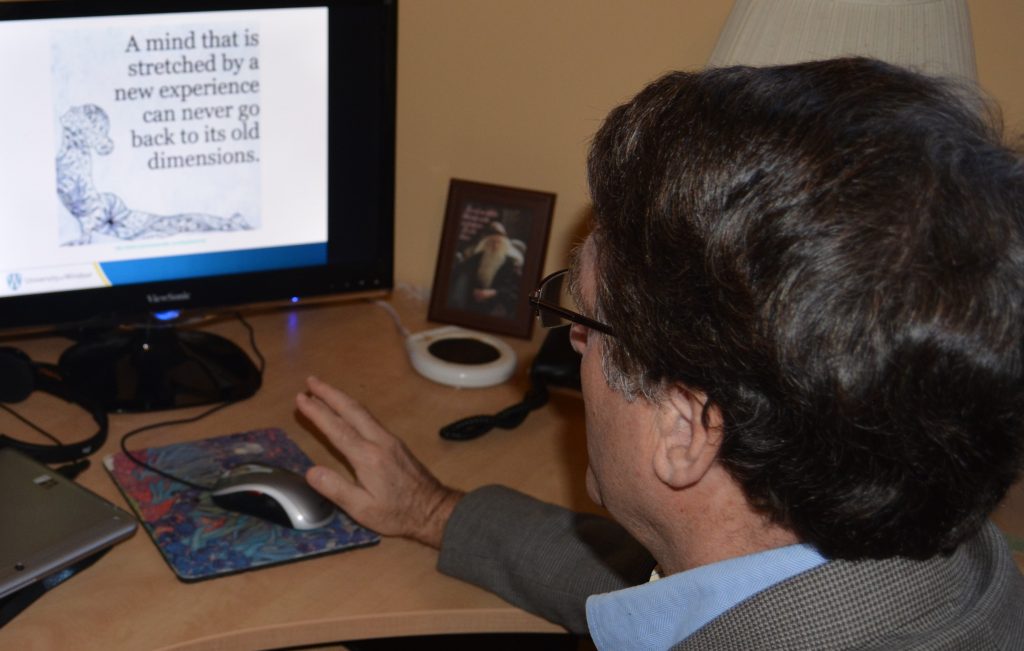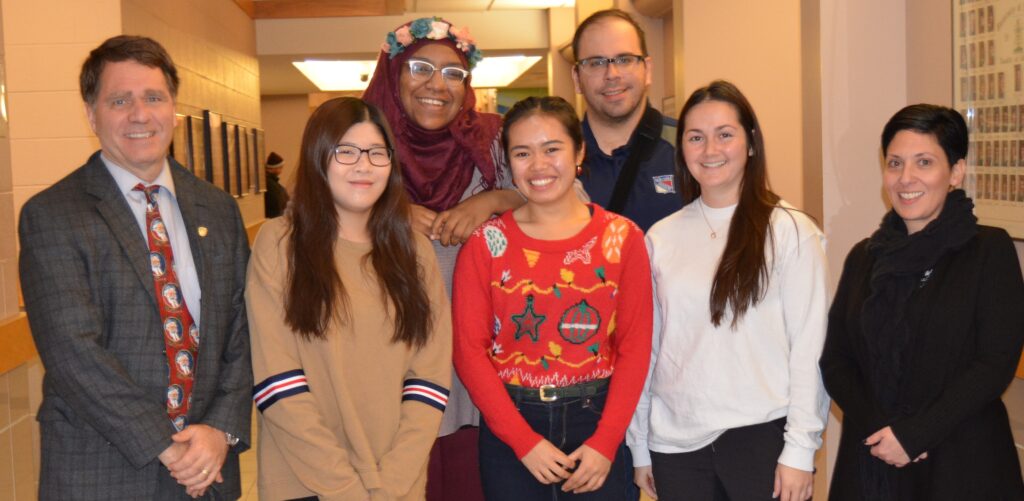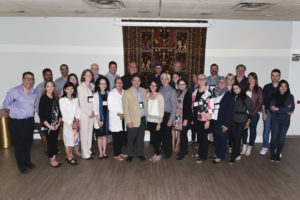Home » Posts tagged 'Open Learning'
Tag Archives: Open Learning
Interrogating Race and Racism in Postsecondary Language Classrooms
Language is power, in the hands of linguistic gatekeepers and the dominant class. From “coloniality of power” (Quijano, 2000) to “coloniality of language” (Veronelli, 2015, p. 113), English has become a “colonial language” (Kachru, 1986, p. 5) and a “language for oppression” (Kachru, 1986, p. 13), replacing the implementation of carrots and sticks in the colonial times in the form of instilling raciolinguistic ideologies of the centre into the periphery. Language is raced and race is languaged (Alim et al., 2016). Racialization, synonymous with racial classification, is a process of “Looking like a Language, Sounding like a Race” (Rosa, 2019). The racialization of language subjugates, subordinates, dehumanizes, and others people of colour.
Join us as we interrogate race and racism in postsecondary language classrooms in our upcoming IGI-Global book. We will use the perspective of intersectionality between language and race in higher education classrooms, by problematizing raciolinguistic injustice and hierarchy with the monolingual and monocultural norm as a frame a reference, combating racism, linguicism, native speakerism, and neo-racism, as well as calling for changes, emancipation, and pedagogical paradigm shifts so as to teach English for justice and liberation (Huo, 2020). This book will investigate race and racism in postsecondary language classrooms, how race intersects with language, how power impacts and shapes language teaching and learning, and how hegemony and ideology perpetuate linguistic injustice and discrimination against racially minoritized students. It will examine how racism has created institutional, structural, and individual barriers for language learners in higher education, as well as potential strategies to combat racism, linguicism, and neo-racism.
We ask prospective contributors to submit research-based and data-driven chapters to elicit stories, counter stories, garner racialized experiences and perspectives, and represent resistant voices through multiple research methods, including but not limited to interviewing, observation, discourse analysis, narrative inquiry, ethnography, journaling, focus groups, surveys, and case studies. Here is the Call for Proposals.
Recommended Topics
- Race, racialization, and racism
- Intersectionality between race and language
- Language and identity
- Linguicism and linguistic imperialism
- Monolingualism, native speakerism, and standardization
- Native-non-native dichotomy
- Power, hegemony, and hierarch
- Raciolinguistic ideology
- Neo-racism (i.e., based on nationalities, ethnicities, and cultures)
- Accentism
- Language diversity and linguistic rights
- Raciolinguistic justice and social justice
- Discourses and stories in different geographic and language teaching contexts across the globe
- Narratives and counter-narratives
- Barriers, challenges, and resistance
- Lived experiences
- Multilingualism, plurilngualism, and translanguaging
- Anti-oppressive and decolonizing language policies
- Anti-racist and anti-colonial pedagogies and practices
- Critical pedagogies in global higher education language teaching contexts
- Ethical internationalization in postsecondary language classrooms
This book is intended for scholars, researchers, faculty, instructors, and professionals in English language teaching, higher education, language education, applied linguistics, sociolinguistics, educational linguistics, anti-racist education, critical multilingual studies, translingual studies, and those who are interested in the research of race, language, and the area of teaching English cross-culturally and translingually in higher education classrooms, such as faculty and instructors, educational developers who design the inclusive, anti-racist, and anti-colonial curriculum, and administrators and policymakers who oversee academic, especially language programs. The book will also be useful for teacher candidates, non-native English-speaking students, undergraduates, and graduate students in TESOL/ESL, second language acquisition, and higher education programs.
Important Dates
- March 31, 2023: Proposal Submission Deadline
- April 14, 2023: Notification of Acceptance
- May 14, 2023: Full Chapter Submission
- June 27, 2023: Review Results Returned
- August 8, 2023: Final Acceptance Notification
- August 22, 2023: Final Chapter Submission
If you would like to discuss a potential book chapter idea, contact us at raceandlanguage@gmail.com.
-Xiangying Huo (University of Toronto) and Clayton Smith (University of Windsor)
References
Alim, S., Rickford, J. R. & Ball, A. F. (Eds.) (2016). Raciolinguistics: How Language Shapes Our Ideas about Race. New York, NY: Oxford University Press.
Huo, X. Y. (2020). Higher education internationalization and English language instruction: Intersectionality of race and language in Canadian universities. Springer. doi:10.1007/978-3-030-60599-5
Kachru, B. B. (1986). The alchemy of English: The spread, functions and models of non-native Englishes. Pergamon.
Quijano, A. (2000). The coloniality of power and social classification. Journal of World-Systems Research 6(2), 342-386.
Rosa, J. (2019). Looking like a language, sounding like a race: Raciolinguistic ideologies and the learning of Latinidad. Oxford University Press.
Veronelli, G. A. (2015). Five: The coloniality of language: Race, expressivity, power, and the darker side of modernity. Wagadu: a Journal of Transnational Women’s and Gender Studies, 13, p. 108-134.
Teaching Through the Screen
Earlier this week, during the virtual Fierce Education conference titled, Higher Education: Helping Faculty Navigate top Challenges in this New Blending Learning Environment, I had the opportunity to take in a talk presented by Sean Michael Morris, vice-president, academics at Course Hero. In his presentation, “Teaching through the Screen: Engaging Imagination to Engage Students,” Sean spoke about critical pedagogy as a humanizing pedagogy; that our focus should be on “seeking the human behind the screen, the human behind the bureaucracies of education, the human behind behaviorist technologies.” So, put another way, we should not teach to the screen (after all it is just a digital tool!), but look through it to those behind the screen who we are teaching. Only by changing our perception of online learning will we be truly able to engage our students. Wow, what a revelation!

Looking into the distance at the Cliffs of Moher, Ireland
Sean introduced us to Maxine Green who wrote in 2000 that “Our obligation today is to find ways of enabling the young to find their voices, to open their spaces, to reclaim their histories in all their variety and discontinuity” (Releasing the Imagination, 120). Imagination, as a “practice of freedom,” can inspire us to change the way we reach our learners. With the COVID-19 experience and our two-year pivot to online learning, this is more needed today than ever.
He then reminded us of what Jesse Stommel said about starting by trusting our students and emphasized that students are producers of knowledge, not just consumers of knowledge. Remembering that the more we know, the less we imagine, can be a powerful learning concept. Engaging students in a learning partnership is empowering for both learners and instructors. In a 2014 interview, Stommel commented:
Learning is always a risk. It means, quite literally, opening ourselves to new ideas, new ways of thinking. It means challenging to engage the world differently. It means taking a leap, which is always done better from a sturdy foundation. This foundation depends on trust – trust that the ground will not give way beneath us, trust for teachers, and trust for our fellow learners in a learning community.
-Jesse Stommel
So, what if we trusted our students as co-learners and used our imagination to see through the screen?
While this may have been true pre-pandemic, it is even more true now. The days of students coming to us to attend in-person classes in university lecture halls have probably changed. An increasing number of students will probably be seeking online courses, be they synchronous, asynchronous, or blended. They will be the new traditional learners in post-secondary or tertiary learning. We will need to trust them and encourage their learning by “seeking the human behind the screen.”
I am ready!
-Clayton Smith
Scary and Fascinating: Online Teaching in Challenging Times
Have you ever started writing on a topic and then something happens that changes everything? Well, that just happened to me. About a month prior to the COVID-19 pandemic, I was writing on the growing interest in and support for open and online learning in postsecondary education. Then poof! COVID-19 changed everything. Today I will share with you some of my initial thoughts on this topic and then reflect on how the events of the last month changed some of my thinking.
Here are some of my initial thoughts.

Following completion of the University of Windsor Office of Open Learning’s Certificate of Online and Open Learning and attendance at eCampusOntario’s Technology + Education Seminar + Showcase (TESS) conference, I initiated a study to explore the connection between the promising practices for teaching online linguistically and culturally diverse international students and student satisfaction and student perceptions of learning, which has recently received research ethics approval but is now paused. An overview of this study is available on my faculty web page. Also, working with two University of Windsor colleagues (Mark Lubrick and Carson Babich), I oversaw the writing of my first Open Educational Resource textbook (Leadership and Management in Learning Organizations), which we hope to publish in the next few months. All of this opened my eyes to the possibilities of online learning within the higher education sector.
And then, just before the pandemic broke, I enjoyed reading the Wiley Education Services study, “Student Perspectives of Online Programs: A Survey of Learners Supported by Wiley Education Services” (Magda & Smalec, 2020), in which student satisfaction with online learning was explored at 19 institutions where students were enrolled in Wiley-supported programs. The study provided some fascinating insights that showed ways to better meet student needs and expectations, including examine the complete student journey to remove barriers to flexibility, create a consistent learning experience to alleviate unneeded stress, and empower faculty to engage with students to improve the learning experience.
And here is a little of what we knew about online learning in North America before COVID-19.

North American online education has seen a rise in popularity in recent years. The Canadian Digital Learning Research Association reported that Canadian postsecondary online course registrations grew by 10 percent in 2018 and 2019, and most institutions expect enrollments to increase in the coming year (Johnson, 2019). The U.S.-based National Center for Education Statistics (Ginder, Kelly-Reid, & Mann, 2017) reported that the number of students who take at least some of their courses online grew by 5.7 percent in 2017. More than 25 percent of students take at least one online course during their time at university of college (Cook, 2018). Undergraduate international students attending Canadian institutions are increasingly choosing to take online courses (Best Colleges, 2019; Thomson, & Esses, 2016).
And here is some of my thinking since COVID-19 joined our world.
Like most faculty, I found myself scrambling a bit to convert my in-person courses, some of which were hybrid courses, to fully online courses. With lots of support from our Office of Open Learning and Centre for Teaching and Learning, as well as experienced colleagues, I made the leap. It was a bit scary, but also fascinating.
On the scary side, there is me. While I had recently acquired professional development in open and online learning, I am an in-person educator who greatly enjoys the interaction with students. Seeing their smiles and their fears is a big part of how I ensure a learning-centred classroom environment. When this all moved to being digital, I, like many of my colleagues, was petrified. Then there are my students, who were equally scared since all of this happened within the last three weeks of the semester. Fortunately, our university put in place a flexible approach that included assessments and grades, which allayed many of their fears. But not all.
When I had my students online, I asked them about their experience. Here is what an international graduate student said:
While we miss the in-person connections with other students and our professors, going online was not really a problem. When I delivered a facilitated reading discussion, I found that I had more confidence due to my comfort with digital technology. I also found that there was more participation in class. Although in-person instruction is my preference, I found aspects of my online classes to be better than expected. In some cases, preferable to my in-person experience!
I also found the whole process fascinating. What we know is that our classes are filled with digital natives; that is, students who have always had technology in their lives. Taking ourselves, who might be described as digital immigrants, out of our comfort zone and letting students be our guides through this new digital world I found exciting and a little fun. It provided a flipped classroom of sorts where the students were doing some of the teaching, and we became the students. What could be more exciting?
Like many other postsecondary institutions, my university is offering its summer courses fully-online. There is also the likely possibility that fall classes similarly will be fully-online. Finishing off a term with online lectures is one thing. Moving to all courses, from beginning to end, being online is something all together different. The good news is we will all be doing it together.
Scary but fascinating!
-Clayton Smith
Best Colleges (2019). 2019 Online Education Trends Report. https://res.cloudinary.com/highereducation/image/upload/v1556050834/BestColleges.com/edutrends/2019-Online-Trends-in-Education-Report-BestColleges.pdf
Cook, J. (2018). Online education and the emotional experience of the teacher. New Directions for Teaching and Emotion. DOI: 10.1002/tl.20282
Ginder, S. A., Kelly-Reid, J. E., & Mann, F. B. (2017). Enrollment and employees in postsecondary institutions, fall 2016; and financial statistics and academic libraries, fiscal year 2016. Washington, DC: National Center for Education Statistics. https://nces.ed.gov/pubs2018/2018002.pdf
Johnson, N. (2019). Tracking online education in Canadian universities and colleges: National survey of online and digital learning 2019 national report. https://onlinelearningsurveycanada.ca/publications-2019/
Magda, S. J., & Smalec, J.S. (2020). Student perspectives on online programs: A survey of learners supported by Wiley Education Services. Louisville, KY: Wiley edu, LLC. https://edservices.wiley.com/student-perspectives-on-online-programs/
Thomson, C., & Esses, V. (2016). Helping the transition: mentorship to support international students in Canada. Journal of International Students, 6(4), 873-886. http://ojed.org/index.php/jis/article/view/323/247
Connecting Today’s Postsecondary Classroom to the Open Future
Postsecondary presidents and administrators are concerned about the rising cost of textbooks, with 85% of leaders supporting the use of OER’s (Lederman, 2019, March 13). Many education faculty members are increasingly looking to make use of OERs to customize their teaching resources to ensure that they are a good fit for the courses they are teaching. This is especially true for instructors engaged in teaching interdisciplinary courses in educational administration, policy, and leadership where there is no currently available open or online textbook.
At this year’s Canadian Society for the Study of Higher Education Conference, which will be held May 31-June 2, 2020 at Western University in London, Ontario, I will be joined by two of my University of Windsor colleagues (Mark Lubrick and Carson Babich) as cochairs for the panel, “Connecting Today’s Postsecondary Classroom to the Open Future: Open Education Resources (OER’s) Empower the Teaching of Educational Administration, Policy, and Leadership,” which will focus on the use of OER’s to teach interdisciplinary courses through the exploration of new pedagogical approaches.

This panel will focus on two main research questions. How are postsecondary faculty making use of OER’s to teach interdisciplinary courses in educational administration, policy, and leadership with a particular focus on learning organizations? What specific factors should be considered when using OER’s to teach interdisciplinary courses?
Consider submitting a proposal. Some possible topics that you may want to consider could include: accessibility, class discussions, connection from one discipline to another, epistemology, equity, ethics evaluating/choosing a resource, experiential learning, flipped teaching, online collaborative teaching (OCT), pedagogical innovation, and research done around OER use in interdisciplinary courses
For more information contact me at Clayton.Smith@uwindsor.ca.
-Clayton Smith
Taking the Plunge

After more than 30 years engaged in higher education administration in the U.S. and Canada, I took the plunge and returned to my teaching roots. And what an adventure it has been!
I took nearly everything that our Centre for Teaching and Learning offered as a way of rebooting and modernizing my approach to teaching. This took me through the Certificate in University Teaching, Blackboard Boot Camp, the Teaching Dossier Academy, and lots more. I learned about SoTL and scholarly teaching. It resulted in me adopting “teaching for learning” as my teaching style, which, of course, was a perfect match to my dean of students’ experiences putting students first in all we do.
More recently, I have explored the open practice world with the help of our Office of Open Learning. It has left me inspired to move away from traditional pedagogies and adopt a more open path to teaching and learning. This led me to explore educational technologies, curation, collaboration, experimentation, and scholarship related to open practice. I am even currently considering the development of an Open Educational Resource for one of my courses and have now created an ePortfolio!
The combination of “teaching for learning” and entering the open learning world has led me to want to learn more about how we as educators, teachers, researchers, and supporters of student learning can more fully centre our work on enhancing student learning.
Where this adventure will lead me, I do not know. What I hope is that it will make me a better teacher, facilitator, mentor, and coach for my students.
I cannot wait to experience what is next on my journey.
From time to time, I will write in this blog about my experiences. Maybe you will tune in and reflect with me about how you incorporate “teaching for learning” and open learning pedagogies in your teaching.
Join me!
Clayton Smith
Recent Comments